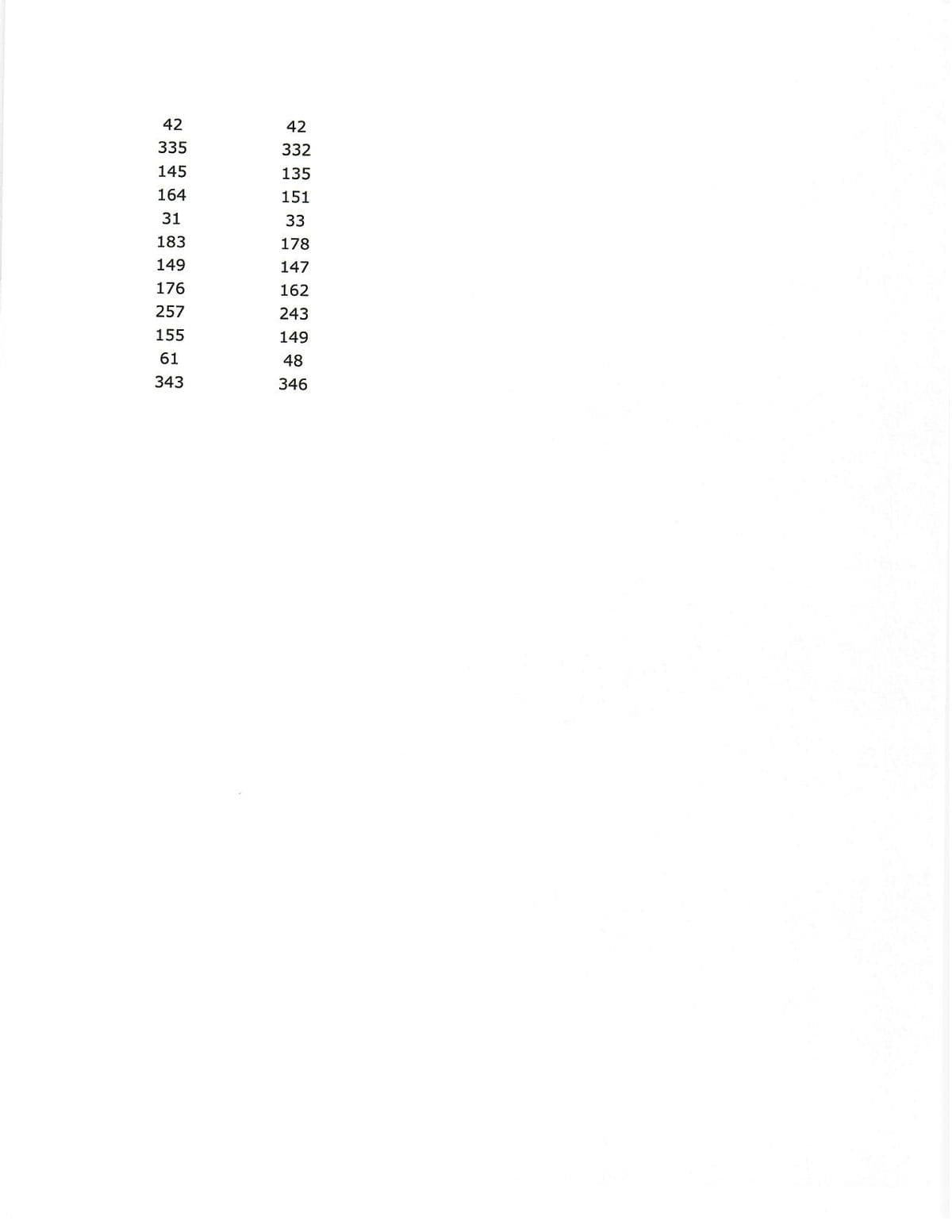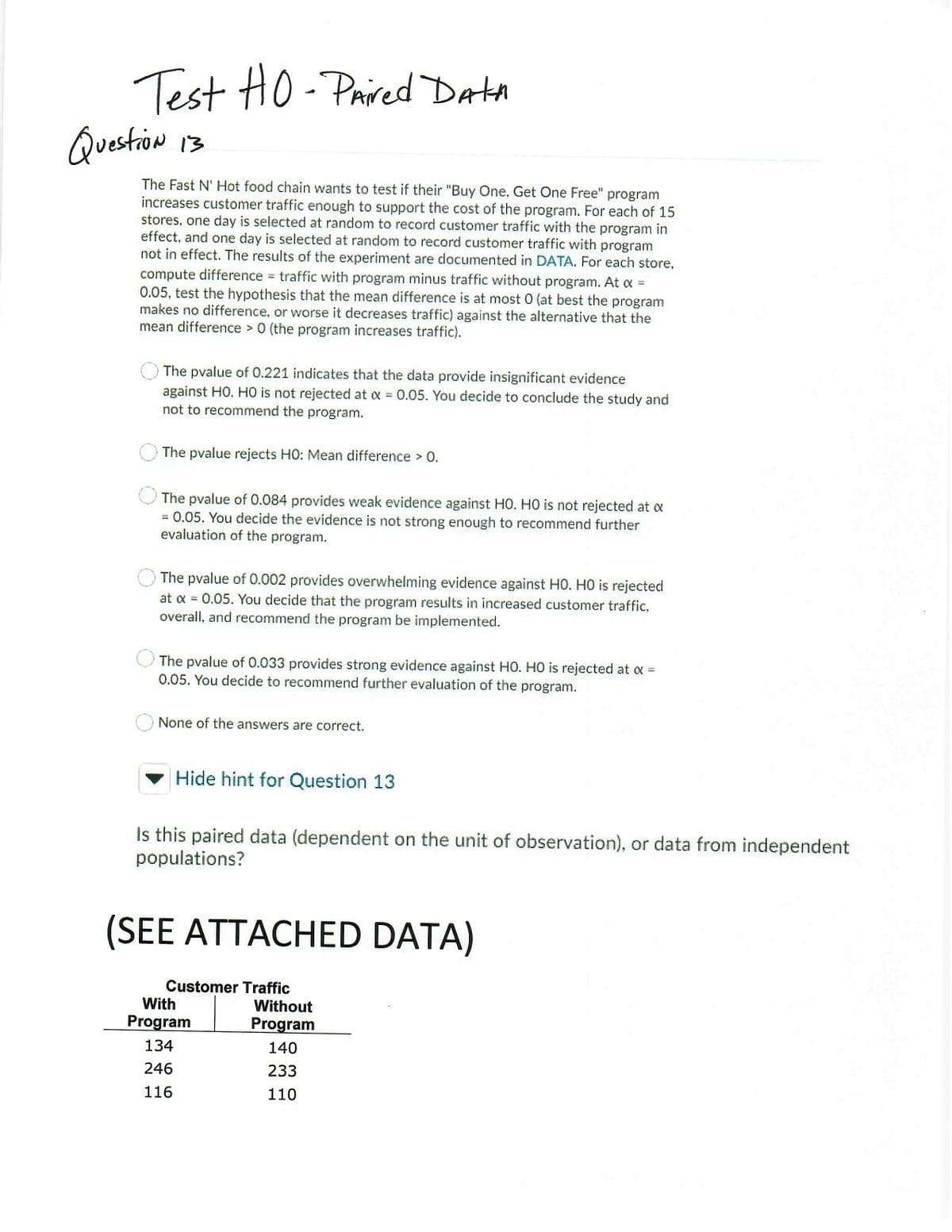The Fast N' Hot food chain wants to test if their "Buy One. Get One Free" program increases customer traffic enough to support the cost of the program. For each of 15 stores, one day is selected at random to record customer traffic with the program in effect, and one day is selected at random to record customer traffic with program not in effect. The results of the experiment are documented in DATA. For each store, compute difference = traffic with program minus traffic without program. At x = 0.05, test the hypothesis that the mean difference is at most 0 (at best the program makes no difference, or worse it decreases traffic) against the alternative that the mean difference > 0 (the program increases traffic). The pvalue of 0.221 indicates that the data provide insignificant evidence against HO. HO is not rejected at a = 0.05. You decide to conclude the study and not to recommend the program. The pvalue rejects HO: Mean difference > 0. The pvalue of 0.084 provides weak evidence against HO. HO is not rejected at a = 0.05. You decide the evidence is not strong enough to recommend further evaluation of the program. The pvalue of 0.002 provides overwhelming evidence against HO. HO is rejected at a = 0.05. You decide that the program results in increased customer traffic, overall, and recommend the program be implemented. The pvalue of 0.033 provides strong evidence against HO. HO is rejected at a = 0.05. You decide to recommend further evaluation of the program. None of the answers are correct. Hide hint for Question 13 Is this paired data (dependent on the unit of observation), or data from independent populations?
The Fast N' Hot food chain wants to test if their "Buy One. Get One Free" program increases customer traffic enough to support the cost of the program. For each of 15 stores, one day is selected at random to record customer traffic with the program in effect, and one day is selected at random to record customer traffic with program not in effect. The results of the experiment are documented in DATA. For each store, compute difference = traffic with program minus traffic without program. At x = 0.05, test the hypothesis that the mean difference is at most 0 (at best the program makes no difference, or worse it decreases traffic) against the alternative that the mean difference > 0 (the program increases traffic). The pvalue of 0.221 indicates that the data provide insignificant evidence against HO. HO is not rejected at a = 0.05. You decide to conclude the study and not to recommend the program. The pvalue rejects HO: Mean difference > 0. The pvalue of 0.084 provides weak evidence against HO. HO is not rejected at a = 0.05. You decide the evidence is not strong enough to recommend further evaluation of the program. The pvalue of 0.002 provides overwhelming evidence against HO. HO is rejected at a = 0.05. You decide that the program results in increased customer traffic, overall, and recommend the program be implemented. The pvalue of 0.033 provides strong evidence against HO. HO is rejected at a = 0.05. You decide to recommend further evaluation of the program. None of the answers are correct. Hide hint for Question 13 Is this paired data (dependent on the unit of observation), or data from independent populations?
Functions and Change: A Modeling Approach to College Algebra (MindTap Course List)
6th Edition
ISBN:9781337111348
Author:Bruce Crauder, Benny Evans, Alan Noell
Publisher:Bruce Crauder, Benny Evans, Alan Noell
Chapter5: A Survey Of Other Common Functions
Section5.6: Higher-degree Polynomials And Rational Functions
Problem 5E: Population Genetics In the study of population genetics, an important measure of inbreeding is the...
Related questions
Question
Please see attached.

Transcribed Image Text:42
42
335
332
145
135
164
151
31
33
183
178
149
147
176
162
257
243
155
149
61
48
343
346

Transcribed Image Text:Test HO- Prired Data
Question i3
The Fast N' Hot food chain wants to test if their "Buy One. Get One Free" program
increases customer traffic enough to support the cost of the program. For each of 15
stores, one day is selected at random to record customer traffic with the program in
effect, and one day is selected at random to record customer traffic with program
not in effect. The results of the experiment are documented in DATA. For each store,
compute difference = traffic with program minus traffic without program. At a =
0.05, test the hypothesis that the mean difference is at most 0 (at best the program
makes no difference, or worse it decreases traffic) against the alternative that the
mean difference > 0 (the program increases traffic).
The pvalue of 0.221 indicates that the data provide insignificant evidence
against HO. H0 is not rejected at a = 0.05. You decide to conclude the study and
not to recommend the program.
The pvalue rejects HO: Mean difference > 0.
The pvalue of 0.084 provides weak evidence against HO. HO is not rejected at a
= 0.05. You decide the evidence is not strong enough to recommend further
evaluation of the program.
The pvalue of 0.002 provides overwhelming evidence against HO. HO is rejected
at x = 0.05. You decide that the program results in increased customer traffic,
overall, and recommend the program be implemented.
The pvalue of 0.033 provides strong evidence against HO. HO is rejected at o =
0.05. You decide to recommend further evaluation of the program.
None of the answers are correct.
Hide hint for Question 13
Is this paired data (dependent on the unit of observation), or data from independent
populations?
(SEE ATTACHED DATA)
Customer Traffic
With
Without
Program
Program
134
140
246
233
116
110
Expert Solution
This question has been solved!
Explore an expertly crafted, step-by-step solution for a thorough understanding of key concepts.
This is a popular solution!
Trending now
This is a popular solution!
Step by step
Solved in 2 steps with 1 images

Knowledge Booster
Learn more about
Need a deep-dive on the concept behind this application? Look no further. Learn more about this topic, statistics and related others by exploring similar questions and additional content below.Recommended textbooks for you

Functions and Change: A Modeling Approach to Coll…
Algebra
ISBN:
9781337111348
Author:
Bruce Crauder, Benny Evans, Alan Noell
Publisher:
Cengage Learning

Holt Mcdougal Larson Pre-algebra: Student Edition…
Algebra
ISBN:
9780547587776
Author:
HOLT MCDOUGAL
Publisher:
HOLT MCDOUGAL

Algebra & Trigonometry with Analytic Geometry
Algebra
ISBN:
9781133382119
Author:
Swokowski
Publisher:
Cengage

Functions and Change: A Modeling Approach to Coll…
Algebra
ISBN:
9781337111348
Author:
Bruce Crauder, Benny Evans, Alan Noell
Publisher:
Cengage Learning

Holt Mcdougal Larson Pre-algebra: Student Edition…
Algebra
ISBN:
9780547587776
Author:
HOLT MCDOUGAL
Publisher:
HOLT MCDOUGAL

Algebra & Trigonometry with Analytic Geometry
Algebra
ISBN:
9781133382119
Author:
Swokowski
Publisher:
Cengage